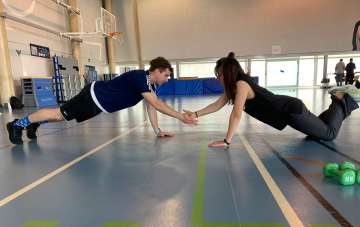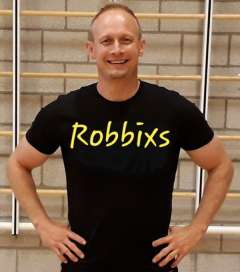Classroom Corner: A conversation with an international PE teacher on movement outside of PE
12/02/2019

In April 2019, the UCLA Health Sound Body Sound Mind team participated in an international physical education conference in Barcelona, Spain. There, we met and interviewed international PE teacher, Robert Alexander Smal, whose goal, in addition to teaching lifelong fitness, is to encourage classroom teachers to get their students moving by offering active breaks in between periods of learning. This idea of an active break is beneficial for classroom teachers, physical education teachers, and most importantly, for students.
Movement breaks, also known as “brain breaks,” are short intervals intended to allow students to get out of their seats and re-energize their minds. The campaign to encourage movement in the classroom is structured to help teachers engage students in physical ways, providing an outlet which maximizes attention span and ultimately, increase learning.
The research cited by Edutopia.org indicates brain breaks led to an increase in productivity, as well as provided opportunities to develop creativity and social skills. Teachers from a 2016 study reported that shorter lessons from taking brain breaks helped keep students engaged, decreased stress, and boosted brain function.
A 2015 study on whether brain breaks helped or hindered classroom learning determined that the brain needs frequent “downtime” for optimal learning. The study also found that the brain thrives on movement. When paired together, students retained more information.
There are many benefits to daily physical activity and PE teachers wholeheartedly understand how their impact in the gym or on the field, directly affects the output in the classroom.

Robert Smal is a very experienced, dedicated and creative physical and health education teacher in the Netherlands. In addition to teaching PE, Robert is specialized and active as an instructor in various sports disciplines: strength and conditioning, mixed martial arts, kickboxing, swimming and running. His clientele consists both of students from the school he works at and adults seeking fitness training.
Jocelyn: How did you get started teaching PE?
Robert: Fitness and martial arts have always been a great part of life. Since I was very young, I noticed that I was keen on teaching other people to do the same and thus it only made sense for me to study physical education at The Hague University for Applied Sciences. During my first year working as a PE teacher, I combined a job at a local primary school with a job at a secondary school which also had an international stream. From that moment on I was hooked on teaching PE in international schools, working with kids and teenagers from all over the world who show a genuine interest in their education.
Jocelyn: What do you love most about what you do?
Robert: I think the interactions with young people are what really keeps my passion alive. I think those moments are key.
Jocelyn: What are some of the strengths of teaching physical education?
Robert: Well, the strength is that it really brings balance to the lives of students. I think it’s important that they have the opportunity to both exercise and learn about exercise when they go to school. They must regularly have moments of movement during their day at school. Since many people around the world still associate school with sitting behind a desk, it is my strong wish to see an increase in those moments of movement on a global level.
Jocelyn: How do you come up with what you are going to teach?
Robert: It depends on many factors. Let’s say we start with facilities. We ask, “what do we have available?” Then, we look at equipment, “what do we already have?” Next, we look at our team, “what are the interests and specializations of our team?” Then, of course, we ask, “what would we like our students to do?”
My philosophy in physical education has always been to introduce students to a wide variety in the sports culture. I wouldn’t focus on the introduction of just one sport as a unit. I prefer conceptual education and thus I would rather focus on positioning within the field and communication within a team. I would offer sports in which the same concept can be applied. Field hockey, football, basketball and ultimate would be offered in the same unit. Teaching in this manner increases students’ understanding of concepts, collaborative skills, spatial awareness, development of different motor skills - and, above all, offers students many opportunities to experience success. While one student shows excellence in the skills of a specific sport, another student who has a basic level in skills, shows a great understanding of the concept applied in other sports.
Jocelyn: What about challenges as a PE teacher?
Robert: The biggest challenge is to convince other people that physical education, or better said regularity in implementing moments of movement (also outside of PE lessons), is essential for a high-quality life. For a long time, PE teachers had to fight to let our profession and subject take their rightful and well-deserved place. PE has been the underdog in education and sometimes it seems like it still kind of is. Unfortunately, some people think: “Oh, you’re a PE teacher. You just give a ball and they play”. But no, it is not just that. Our profession and teaching subject encompass so much more. It would be great to see more and more people all around the world recognize the importance of physical education forour health and well-being, the functionality of our brain and academic performance.
Jocelyn: What do you want other PE teachers to take away from this?
Robert: I want them to think to themselves, “how can I help increase the importance of physical education in the part of the world, the country, and society I live in? What can I do to encourage other people to implement more moments of movement in their lives?”
Photos:
Upper: International physical education teachers try the UCLA Health Sound Body Sound Mind curriculum at an international PE conference in Barcelona.
Lower: International physical education teacher, Robert Smal